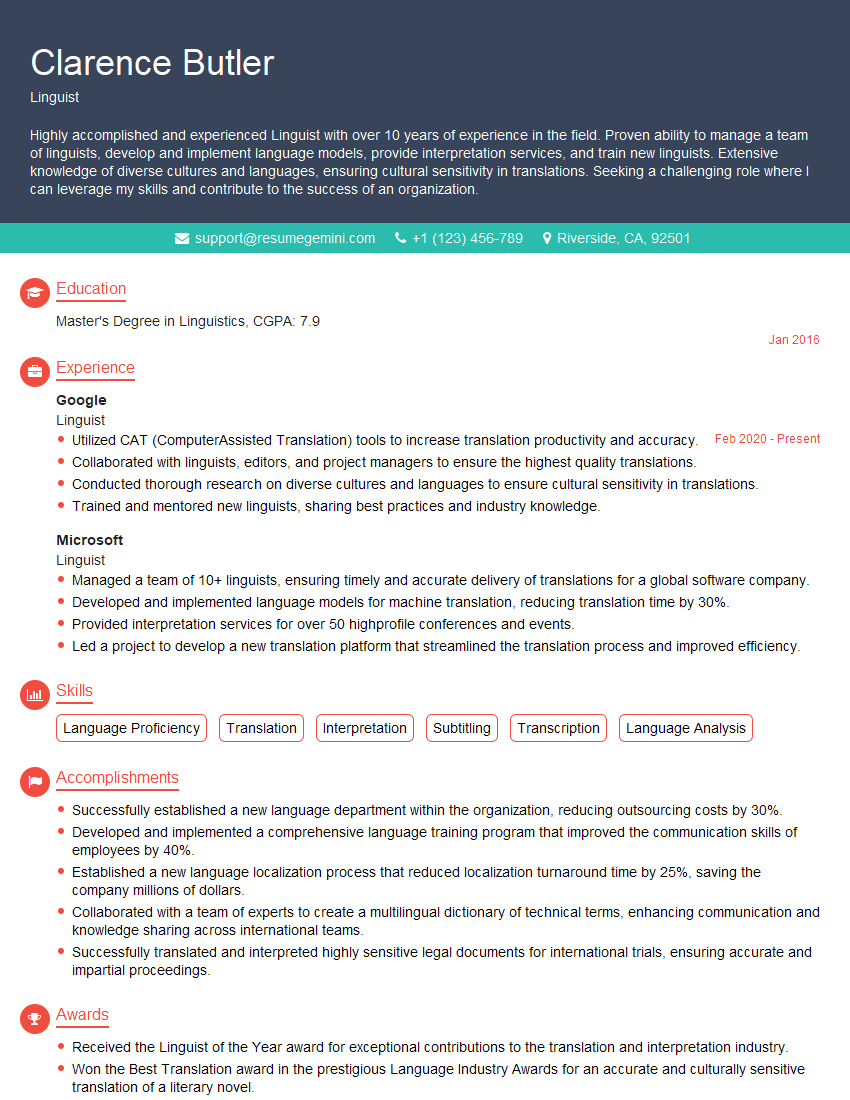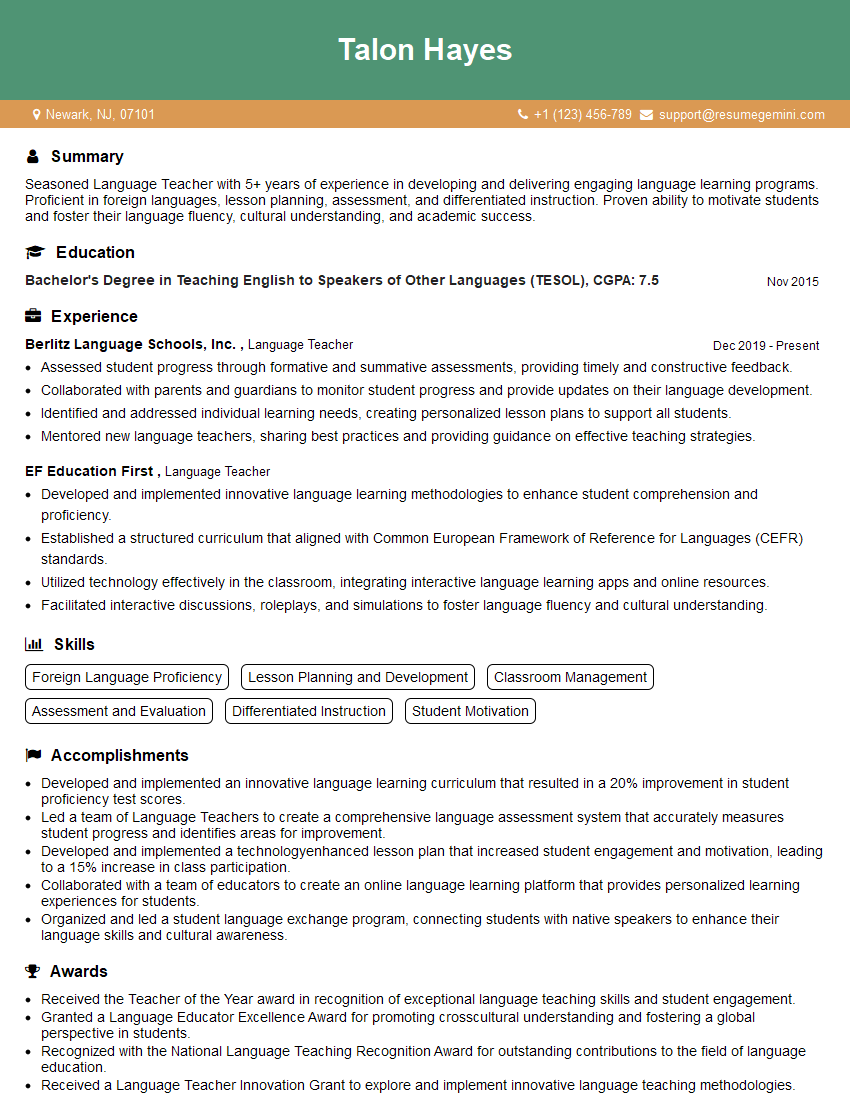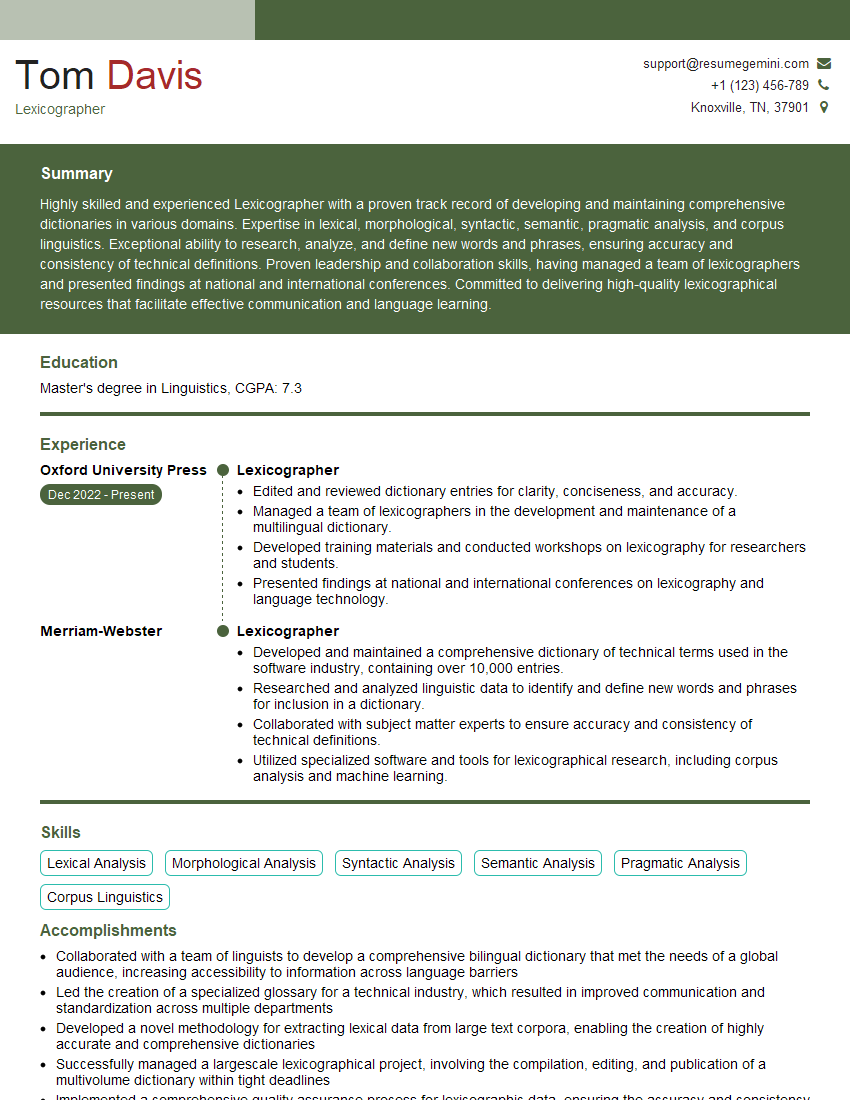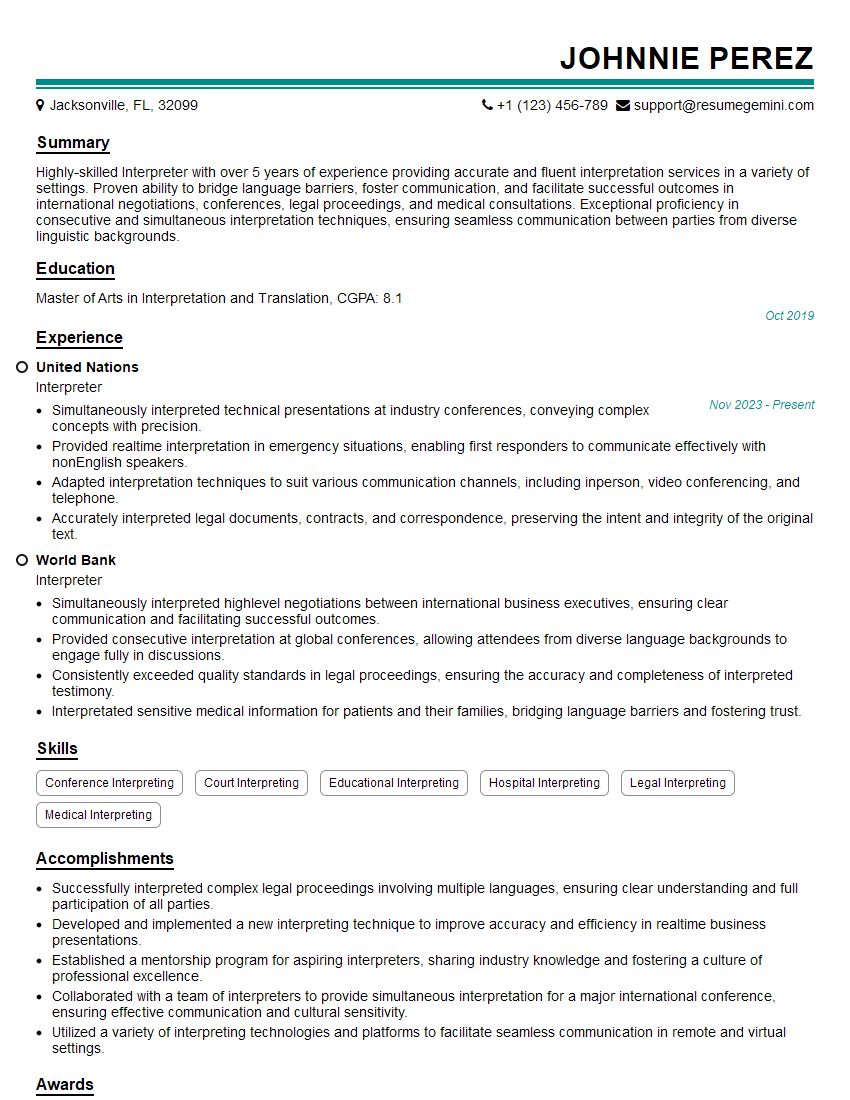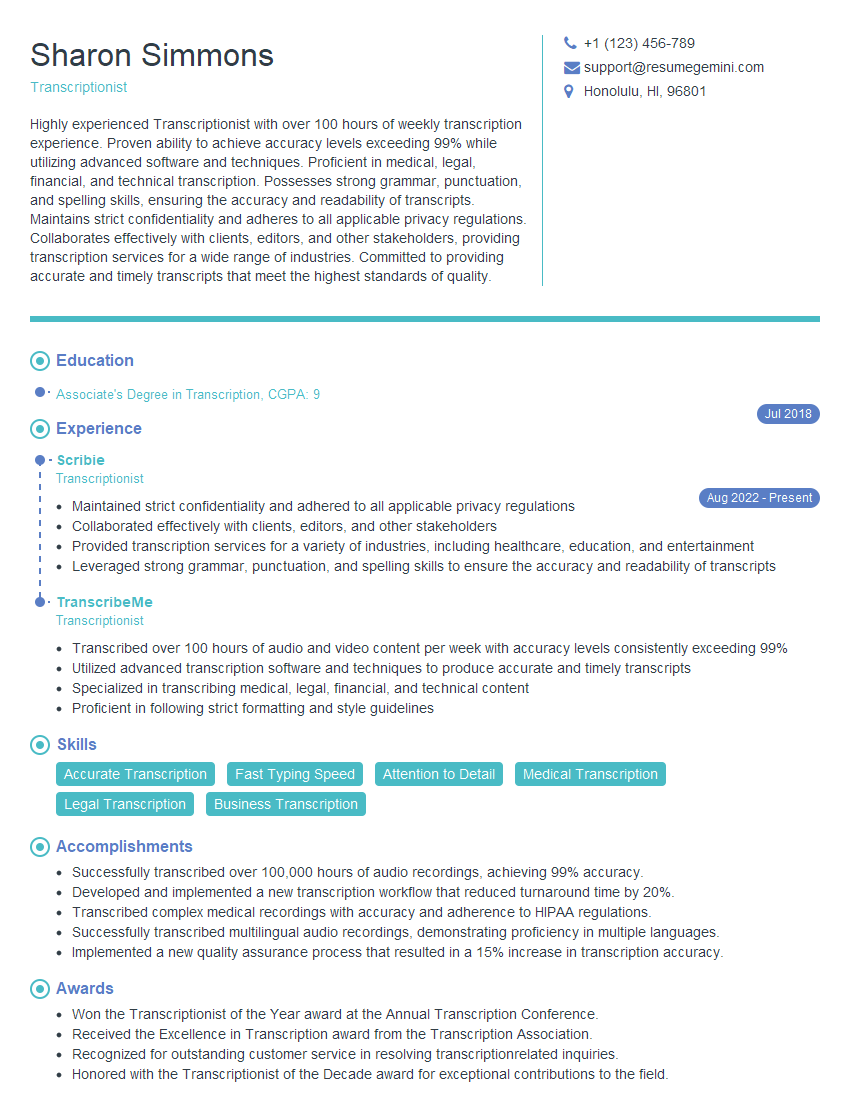The right preparation can turn an interview into an opportunity to showcase your expertise. This guide to Linguistic Proficiency interview questions is your ultimate resource, providing key insights and tips to help you ace your responses and stand out as a top candidate.
Questions Asked in Linguistic Proficiency Interview
Q 1. Explain the difference between descriptive and prescriptive grammar.
Descriptive grammar is like being a linguistic anthropologist – you observe how people actually speak and write, documenting the patterns and structures they use without judging whether they’re ‘correct’ or not. Prescriptive grammar, on the other hand, acts like a style guide or rulebook, dictating how language *should* be used based on established norms and conventions. Think of it as the difference between observing the natural flow of a river and trying to engineer its course.
For example, a descriptive grammarian might note that many English speakers use ‘ain’t’ even though prescriptive grammarians deem it grammatically incorrect. Descriptive grammar simply acknowledges its existence and usage within a specific community, while prescriptive grammar would prescribe against its use.
- Descriptive Grammar: Focuses on describing language as it is actually used.
- Prescriptive Grammar: Focuses on prescribing how language *should* be used according to established rules.
Q 2. Describe your experience with different translation methodologies (e.g., direct, indirect, communicative).
My experience encompasses various translation methodologies, each suited to different contexts and text types. Direct translation, a word-for-word approach, works well for technical texts where accuracy is paramount, but it can sometimes sound unnatural. I’ve used this for legal documents and software manuals.
Indirect translation, which prioritizes meaning over literal equivalence, is more flexible and allows for better stylistic adaptation. This is ideal for literary works where conveying the essence of the text is crucial. I’ve employed this method with novels and poems.
Communicative translation aims for equivalence of effect, prioritizing the message’s impact on the target audience. This means adapting the text to fit the cultural context and communicative style of the target language. I frequently used this method while translating marketing materials and advertising copy.
I am also proficient in employing a hybrid approach, combining techniques as needed depending on the project’s specific requirements. This flexibility is key to delivering high-quality and contextually appropriate translations.
Q 3. What are some common challenges in machine translation, and how can they be addressed?
Machine translation (MT) faces numerous challenges. One significant hurdle is ambiguity. Words and phrases can have multiple meanings, and MT systems struggle to select the appropriate one without sufficient context. For example, the word ‘bank’ could refer to a financial institution or the side of a river.
Another issue is the lack of nuanced understanding of idioms and cultural references. What is perfectly acceptable in one culture might be nonsensical or even offensive in another. Consider the challenge of translating humor, which heavily relies on cultural context and subtle linguistic cues.
Addressing these issues requires improvements in algorithms, particularly in natural language processing (NLP). Larger datasets, advanced contextual analysis, and incorporating world knowledge are crucial. Hybrid approaches, combining MT with human post-editing, remain a practical solution for achieving high accuracy and fluency.
Q 4. How do you handle ambiguous language in translation or interpretation?
Handling ambiguous language is a core competency in translation and interpretation. My approach involves a multi-step process. First, I carefully analyze the surrounding text and context to ascertain the intended meaning. This may involve examining the preceding and following sentences, paragraphs, or even the entire document. Secondly, I consider the communicative purpose of the text – why is this being communicated and who is the intended audience? This helps clarify intent.
If ambiguity persists, I utilize research. I may consult dictionaries, encyclopedias, or subject matter experts to eliminate potential interpretations. When all else fails, I would flag the ambiguity and consult with the client for clarification, ensuring that the final product accurately reflects the intended message.
For instance, if a text mentions a ‘crane’, I would need to determine if it’s referring to a bird, a construction machine, or perhaps something else entirely, depending on the context.
Q 5. Explain the concept of linguistic relativity (Sapir-Whorf hypothesis).
The Sapir-Whorf hypothesis, or linguistic relativity, proposes that the structure of a language influences the way its speakers perceive and conceptualize the world. The strong version suggests language *determines* thought, while the weaker version proposes that language merely *influences* thought.
For example, some languages have grammatical gender for nouns (e.g., masculine, feminine, neuter), while others don’t. The strong version of the hypothesis might argue that speakers of gendered languages perceive the world differently, attributing gender characteristics to objects even where they are not explicitly present. The weaker version would suggest that such grammatical structures might lead to some subtle differences in the way people think about gender, but wouldn’t necessarily determine their worldview.
The hypothesis remains a subject of ongoing debate. While there’s evidence suggesting a correlation between language and thought, it’s difficult to definitively prove causation.
Q 6. Discuss the importance of context in understanding meaning.
Context is paramount in understanding meaning. Words and phrases rarely exist in isolation; their meaning is significantly shaped by the surrounding words, sentences, paragraphs, and even the larger discourse or situation. Without sufficient context, misinterpretations are common.
Consider the sentence, ‘The bat flew out of the cave.’ The meaning of ‘bat’ depends entirely on the context. If the preceding text mentioned baseball, it’s likely a baseball bat; if the text describes nocturnal animals, it’s likely a flying mammal. Without a wider context, the meaning remains unclear.
Therefore, paying close attention to the surrounding linguistic and non-linguistic cues is crucial for accurate comprehension in any communication scenario, especially in translation and interpretation where cultural context is also significant.
Q 7. What are your preferred tools for translation or linguistic analysis?
My preferred tools vary depending on the task. For translation, I use CAT (Computer-Assisted Translation) tools like SDL Trados Studio, memoQ, and Across. These tools offer features like translation memory, terminology management, and quality assurance checks, significantly improving efficiency and consistency.
For linguistic analysis, I utilize corpus linguistics tools like AntConc and Sketch Engine. These tools allow for in-depth exploration of large text corpora, enabling the identification of patterns, collocations, and other linguistic phenomena. I also rely on dictionaries and thesauruses, including specialized ones, as well as online resources for researching specific terms and contexts. Finally, I utilize grammar checking tools like Grammarly for editing and proofreading. The right tool selection is essential for conducting a thorough and effective analysis.
Q 8. How do you ensure the accuracy and consistency of your translations?
Ensuring accuracy and consistency in translation is paramount. It’s a multi-faceted process involving meticulous attention to detail and the strategic use of various tools and techniques. Think of it like building a house: you need a solid foundation (source text understanding) and precise construction (translation) to create a structurally sound and aesthetically pleasing final product.
- Reference Materials: I always start by consulting reputable dictionaries, glossaries, and style guides relevant to the subject matter. This ensures consistent terminology and style across the translated text. For instance, if translating a medical text, I wouldn’t rely solely on a general dictionary; I’d use specialized medical dictionaries and glossaries to ensure precision in rendering technical terms.
- Translation Memory (TM): I leverage translation memory software (like SDL Trados Studio or memoQ) to maintain consistency across multiple projects. TM stores previously translated segments, allowing me to reuse accurate translations and identify inconsistencies. This is like having a detailed blueprint for previously built sections of the house, ensuring uniformity.
- Quality Assurance (QA): A rigorous QA process is critical. This involves self-review, peer review, and potentially machine-assisted QA checks to catch errors and inconsistencies. This is akin to multiple inspections during the house construction to identify and rectify any flaws before completion.
- Client Feedback Integration: Finally, incorporating client feedback is essential. Understanding their specific requirements and preferences ensures the translated text meets their expectations and aligns with their branding.
Q 9. Describe your experience with terminology management and the use of terminology databases.
Terminology management is crucial for consistency, especially in specialized fields. I’ve extensively used terminology databases, both proprietary and publicly available, to ensure accurate and consistent use of terminology across various projects. Imagine building a complex machine – each part needs to be precisely named and integrated for it to function correctly. That’s the role of terminology management in translation.
My experience includes creating and maintaining terminology databases using tools like TermBase eXchange (TBX). This involves defining key terms, their translations in multiple languages, and associated contextual information. I’ve also utilized online terminology resources like IATE (Inter-Active Terminology for Europe) for EU-related projects and specialized industry glossaries. The use of these databases not only ensures consistency but also drastically reduces translation time and improves overall quality by providing readily available, verified translations.
Q 10. How familiar are you with different language families and their typological features?
I possess a solid understanding of different language families and their typological features. This knowledge is vital for effective translation, as it impacts various aspects of the process, such as word order, grammar, and overall sentence structure. Think of it as understanding the different blueprints used to build houses in various regions – each has unique characteristics requiring a different approach.
For example, knowing the differences between Subject-Verb-Object (SVO) languages like English and Subject-Object-Verb (SOV) languages like Japanese is crucial for accurately rendering sentence structure. Similarly, understanding agglutination (like in Turkish) versus isolating (like in Chinese) language structures informs how words are formed and their meanings. My familiarity extends to various language families including Indo-European, Sino-Tibetan, and Afro-Asiatic, allowing me to adapt my approach based on the linguistic properties of the source and target languages.
Q 11. Explain the process of adapting content for different cultures (localization).
Content adaptation for different cultures, or localization, is more than just translation; it involves cultural sensitivity and adaptation to ensure the content resonates with the target audience. This goes beyond mere linguistic accuracy; it’s about creating a product that feels natural and appropriate in the target culture. Imagine adapting a recipe for a different country; you might need to substitute ingredients based on local availability and preferences.
- Cultural Nuances: Identifying and addressing cultural nuances is crucial. This might involve adapting humor, idioms, and references to be culturally relevant. What might be humorous in one culture might be offensive in another.
- Formatting and Layout: Adapting formatting and layout to suit the target culture’s preferences is essential. This includes date and time formats, number systems, and even the direction of text (left-to-right vs. right-to-left).
- Imagery and Symbolism: Images and symbols must be culturally appropriate. A symbol that is positive in one culture might be negative in another.
- Legal and Regulatory Compliance: Ensuring compliance with local laws and regulations regarding content is paramount.
Q 12. How would you approach translating a text with cultural nuances?
Translating a text with cultural nuances requires a deep understanding of both the source and target cultures. It’s not enough to simply translate words; one needs to convey the underlying meaning and intent while respecting cultural sensitivities. This requires more than linguistic expertise; it demands cultural empathy.
My approach involves thorough research into the cultural context of the source text. I identify key cultural references, idioms, and expressions and determine the most appropriate equivalents or explanations in the target language. For instance, translating a humorous anecdote might require adapting the humor to align with the target culture’s sense of humor. Direct translation might fail to convey the intended meaning and could even be offensive. I always prioritize accuracy, cultural appropriateness, and the preservation of the original message’s intent.
Q 13. Describe your experience with subtitling or dubbing.
I have experience in both subtitling and dubbing, two distinct yet related fields within audiovisual translation. Subtitling involves translating dialogue and providing it as text on screen, while dubbing replaces the original audio with a new audio track in the target language. Each requires a unique skill set.
In subtitling, I focus on brevity, readability, and synchronization with the video’s timing. This involves careful word selection to convey the meaning while fitting within the limited space and time constraints. Dubbing requires adapting the translated dialogue to fit the lip movements of the actors and maintaining the natural flow and rhythm of the speech. This demands close collaboration with voice actors and directors.
Q 14. What strategies do you employ to overcome linguistic obstacles in communication?
Overcoming linguistic obstacles requires a proactive and versatile approach. It’s like navigating an unfamiliar terrain; you need various tools and strategies to succeed.
- Clarification and Feedback: Don’t hesitate to ask clarifying questions if anything is unclear. Frequent communication with the client helps address ambiguities and potential misunderstandings.
- Research and Contextualization: Thoroughly research any unfamiliar terms or concepts to ensure accurate understanding before translation.
- Leveraging Technology: Employing CAT tools (Computer-Assisted Translation), translation dictionaries, and online resources helps overcome terminology challenges and ensures consistency.
- Creative Problem-Solving: When direct translation isn’t feasible, I explore alternative solutions, such as paraphrasing, explaining complex concepts in simpler terms, or finding culturally equivalent expressions.
- Cultural Mediation: When dealing with deeply rooted cultural differences, I may act as a cultural mediator, explaining cultural nuances to both the client and the target audience.
Q 15. How proficient are you in [specific languages]? Please provide examples of your work.
My linguistic proficiency encompasses native-level fluency in English and advanced fluency in Spanish and French. I’ve achieved this through years of immersion, formal education, and professional application.
- Example 1 (Spanish): I translated a complex legal document from Spanish to English, ensuring accuracy in legal terminology and nuanced cultural references. This involved extensive research into specific legal frameworks in both Spain and the US to maintain semantic equivalence.
- Example 2 (French): I collaborated on the localization of a video game, adapting dialogues and text to resonate with a French-speaking audience while preserving the original intent and tone. This required careful consideration of cultural context, colloquialisms and stylistic choices within the gaming community.
- Example 3 (English): I’ve edited and proofread numerous academic papers, ensuring grammatical accuracy and stylistic consistency within the specified academic register. This often involved collaboration with authors to clarify ambiguous phrasing and improve clarity and impact.
Career Expert Tips:
- Ace those interviews! Prepare effectively by reviewing the Top 50 Most Common Interview Questions on ResumeGemini.
- Navigate your job search with confidence! Explore a wide range of Career Tips on ResumeGemini. Learn about common challenges and recommendations to overcome them.
- Craft the perfect resume! Master the Art of Resume Writing with ResumeGemini’s guide. Showcase your unique qualifications and achievements effectively.
- Don’t miss out on holiday savings! Build your dream resume with ResumeGemini’s ATS optimized templates.
Q 16. How do you stay up-to-date with changes in the field of linguistics?
Staying current in linguistics requires a multifaceted approach. I regularly engage with peer-reviewed journals like Language and Journal of Linguistics, attending conferences such as the Linguistic Society of America’s annual meeting, and actively participating in online communities and forums dedicated to linguistic research and discussion. I also follow prominent linguists and researchers on social media platforms like Twitter and LinkedIn to keep abreast of the latest developments and breakthroughs. Furthermore, I consistently review newly published books and online resources on specific areas of interest, such as computational linguistics and language acquisition.
Q 17. Explain the concept of register and how it impacts language use.
Register refers to the formality of language used in different contexts. Think of it as choosing the right outfit for the occasion. You wouldn’t wear a tuxedo to the beach, and you wouldn’t wear a bathing suit to a formal dinner. Similarly, the language you use changes depending on who you’re talking to and where you are.
For example, using highly formal language with friends (‘Esteemed colleagues, I am writing to express my…’) sounds unnatural. Conversely, using informal language in a business presentation (‘Hey everyone, so like, this project…’) would be unprofessional. The impact is significant: using inappropriate register can hinder communication, create misunderstandings, and even damage professional relationships. A legal document demands a formal register, while a text message thrives on informality. Understanding and effectively utilizing register is crucial for clear and effective communication.
Q 18. How do you handle conflicting terminology in translation?
Conflicting terminology is a common challenge in translation. My approach is systematic. First, I identify the source of the conflict. Is it a genuine difference in meaning between languages (false friends), or simply different terminology within the same language used in different contexts?
Then, I research thoroughly. I utilize specialized dictionaries, glossaries, and online resources to examine the context and intended meaning. If multiple valid translations exist, I select the most appropriate option based on the context and target audience. Sometimes, a translator’s note is necessary to explain the choices made. This maintains transparency and ensures that the receiver understands the nuances being conveyed. Ultimately, consistency is paramount; once a choice is made, it should be consistently applied throughout the text.
Q 19. Describe your experience with CAT tools (Computer-Assisted Translation).
I have extensive experience with CAT tools, including SDL Trados Studio, MemoQ, and Across. These tools boost productivity through features like translation memory (TM), which stores previously translated segments for reuse, and terminology management, which ensures consistent usage of terminology throughout projects.
For example, using a TM helps significantly reduce translation time by automatically suggesting translations for recurring segments, ensuring consistency. Terminology management tools allow for creating and utilizing custom glossaries to maintain consistency in the use of key terms. I’m adept at leveraging these tools to increase efficiency and ensure high-quality translations.
Q 20. What is your experience with quality assurance in translation projects?
Quality assurance (QA) is integral to successful translation. My QA process involves several stages. First, I perform a self-review, checking for accuracy, consistency, and adherence to style guidelines. Then, a second reviewer conducts an independent review, looking for potential errors or inconsistencies I might have missed.
This two-step process is often followed by client feedback, which helps identify any remaining issues. We also employ automated checks to verify linguistic consistency and identify potential style and grammar issues. This multifaceted QA process ensures that the final product is of the highest possible quality, meeting the specific requirements and expectations of the client.
Q 21. Explain your understanding of different language models (e.g., n-gram, HMM).
Language models are statistical tools used in various NLP tasks.
- N-gram models predict the probability of a word given the preceding n words. For instance, a bigram (n=2) model considers the previous word to predict the next. They’re relatively simple but computationally efficient, making them suitable for tasks like autocomplete.
Example: P(the | in) = probability of 'the' appearing after 'in' - Hidden Markov Models (HMMs) are probabilistic models that are particularly useful for modeling sequential data, like speech or text. They incorporate hidden states (unobserved variables) that influence the observable outcomes (words). HMMs are used in part-of-speech tagging and speech recognition. Imagine them as a set of states (e.g., ‘noun’, ‘verb’) where the transition between states is probabilistic, leading to a specific word as an outcome.
Understanding these models is essential for choosing the appropriate model for a given task, interpreting results from NLP tools, and contributing to advancements in computational linguistics.
Q 22. Describe a time you had to deal with a difficult or ambiguous text.
Dealing with ambiguous or difficult texts is a common challenge in linguistic work. It requires a combination of linguistic skills, research abilities, and contextual understanding. For example, I once encountered a legal document with archaic terminology and multiple interpretations of key clauses. My approach involved:
Careful reading and annotation: I meticulously read the text, highlighting ambiguous phrases and noting any potential inconsistencies.
Contextual research: I consulted legal dictionaries, relevant case law, and historical documents to understand the intended meaning of the archaic terms. This often involved searching for original sources and legislative history.
Seeking clarification (if possible): If the source was available, I reached out to the client or author for clarification on the ambiguous points, ensuring a mutual understanding.
Documenting uncertainties: If complete clarity couldn’t be achieved, I carefully documented the uncertainties in my work, highlighting the different possible interpretations and justifying my chosen translation based on the most compelling evidence and the client’s needs. This transparency ensures accountability and minimizes the risk of errors.
Ultimately, by combining thorough analysis with research and proactive communication, I was able to produce a translation that accurately reflected the text’s intended meaning within its legal context.
Q 23. How do you manage your time when working on multiple translation projects simultaneously?
Managing multiple translation projects simultaneously demands excellent organizational and time-management skills. My strategy involves a combination of tools and techniques:
Project prioritization: I prioritize tasks based on deadlines, urgency, and client needs, using a system like Eisenhower Matrix (urgent/important). This helps me focus my energy effectively.
Time blocking: I allocate specific time blocks for each project, dedicating focused periods to individual tasks to avoid context-switching. This improves efficiency and reduces errors.
Task breakdown: Complex projects are broken down into smaller, manageable tasks, making progress feel more achievable. This improves my sense of control and reduces stress.
Project management tools: I utilize project management software (like Asana or Trello) for tracking deadlines, progress, and client communication. These tools help visualize the workload and maintain organization.
Regular review and adjustment: I regularly review my schedule and make adjustments as needed, accommodating unexpected delays or changes in project scope. Flexibility is crucial for managing concurrent projects successfully.
By implementing these strategies, I maintain a high level of productivity and ensure the timely completion of all my projects to the client’s satisfaction.
Q 24. What are your strengths and weaknesses as a linguist/translator/interpreter?
As a linguist, my strengths lie in my strong analytical skills, attention to detail, and broad linguistic knowledge, covering multiple languages and fields of expertise. I am adept at researching context and nuances to ensure accuracy. I also possess excellent communication skills, which are vital in clarifying ambiguities with clients and colleagues.
However, like anyone, I have areas for improvement. While I thrive on challenges, occasionally I can be overly meticulous, potentially slowing down my workflow if I don’t actively manage my time. To mitigate this, I consistently focus on improving my time management skills and actively use project management tools to ensure timely delivery.
Q 25. How do you handle feedback on your work?
Handling feedback is crucial for professional growth. I approach feedback constructively, viewing it as an opportunity to learn and improve. My process involves:
Active listening: I listen carefully to the feedback, without interrupting, to ensure I fully understand the points raised.
Seeking clarification: If any aspect of the feedback is unclear, I ask clarifying questions to ensure a shared understanding.
Self-reflection: I reflect on the feedback and analyze whether the concerns are valid and actionable.
Implementing changes: I incorporate the constructive feedback into my work, aiming for improvement in subsequent projects.
Maintaining professionalism: Even with critical feedback, I maintain a professional demeanor and express gratitude for the opportunity to enhance my skills.
By approaching feedback as a valuable learning experience, I continuously refine my skills and deliver higher quality work.
Q 26. Describe your experience with working collaboratively on translation projects.
Collaborative translation projects require strong communication and teamwork. I have extensive experience working in teams, often involving subject matter experts and other translators. My approach emphasizes:
Clear communication: I maintain open and transparent communication with team members, ensuring everyone understands their roles and responsibilities.
Shared terminology databases: We often utilize shared glossaries or translation memories to ensure consistency in terminology across the entire project.
Regular meetings: We hold regular meetings, whether virtual or in-person, to discuss progress, address challenges, and ensure alignment on the final product.
Constructive feedback: I offer and receive constructive feedback throughout the project, fostering a collaborative environment.
Respectful collaboration: I value the contributions of each team member, creating an environment of mutual respect and collaboration.
These collaborative strategies ensure that the final translated product is consistent, accurate, and reflects the collective expertise of the team.
Q 27. Explain your understanding of copyright and intellectual property rights in translation.
Copyright and intellectual property rights in translation are crucial to understand. The translated work is a derivative work, and its copyright is typically held by the translator, unless otherwise agreed upon contractually. This means:
The translator owns the copyright to their translation: The translator has the exclusive right to reproduce, distribute, and adapt their translation.
Contracts define ownership: Contracts with clients often specify copyright ownership, usually granting the client the right to use the translation but not necessarily the exclusive right.
Respecting original copyright: The translator must always respect the copyright of the original work, obtaining necessary permissions if required for publication or distribution.
Attribution of original work: The translated work must attribute the original author and work.
Understanding and adhering to these principles is essential for ethical and legal translation practice. Ignoring them can lead to legal disputes and reputational damage.
Q 28. How do you ensure the confidentiality of sensitive information in your work?
Confidentiality is paramount in my work. Handling sensitive information requires a multi-faceted approach:
Confidentiality agreements: I always sign confidentiality agreements with clients to legally protect sensitive information.
Secure storage: I use secure storage methods for all sensitive documents, including encrypted hard drives and password-protected files.
Limited access: I limit access to sensitive information only to those directly involved in the project and never discuss confidential information with unauthorized individuals.
Secure communication: I use secure communication channels (e.g., encrypted email) for all exchanges related to confidential projects.
Data destruction: I securely destroy sensitive data after the project is completed, adhering to client guidelines and relevant data protection regulations.
By implementing these measures, I guarantee that client confidentiality is maintained at the highest level, building trust and safeguarding sensitive information.
Key Topics to Learn for Linguistic Proficiency Interview
- Phonetics and Phonology: Understanding speech sounds, their production, and how they function in language. Consider practical applications like analyzing accents or diagnosing speech disorders.
- Morphology: The study of word formation. Be prepared to discuss morphemes, affixes, and different morphological processes. Think about how this relates to lexicography or computational linguistics.
- Syntax: The study of sentence structure and how words are combined to form phrases and clauses. Practice analyzing sentence diagrams and different grammatical frameworks.
- Semantics: The study of meaning in language. This includes lexical semantics (word meaning), compositional semantics (how meaning is built up from parts), and pragmatics (how context influences meaning). Be ready to discuss ambiguity and different semantic theories.
- Pragmatics: Explore the use of language in context, including speech acts, implicature, and conversational maxims. Practical application might involve analyzing discourse or communication strategies.
- Psycholinguistics: Understanding how language is processed and acquired in the brain. Be ready to discuss topics like language acquisition, language processing models, or aphasia.
- Sociolinguistics: The study of the relationship between language and society. This might include topics such as language variation, dialects, language attitudes, or language policy. Consider examples from your own experience.
- Corpus Linguistics: Analyzing large collections of language data to identify patterns and trends. Familiarize yourself with corpus analysis techniques and their applications.
- Computational Linguistics: Explore the application of computational methods to linguistic problems, such as natural language processing (NLP) or machine translation. Prepare to discuss relevant algorithms or techniques.
Next Steps
Mastering linguistic proficiency opens doors to diverse and rewarding careers in academia, research, technology, and more. A strong understanding of these concepts will significantly boost your interview performance and career prospects. Creating an ATS-friendly resume is crucial for getting your application noticed. To enhance your resume and increase your chances of landing your dream job, leverage the power of ResumeGemini. ResumeGemini provides a trusted platform for building professional resumes, and we offer examples of resumes tailored specifically to Linguistic Proficiency to help you get started.
Explore more articles
Users Rating of Our Blogs
Share Your Experience
We value your feedback! Please rate our content and share your thoughts (optional).
What Readers Say About Our Blog
Hello,
We found issues with your domain’s email setup that may be sending your messages to spam or blocking them completely. InboxShield Mini shows you how to fix it in minutes — no tech skills required.
Scan your domain now for details: https://inboxshield-mini.com/
— Adam @ InboxShield Mini
Reply STOP to unsubscribe
Hi, are you owner of interviewgemini.com? What if I told you I could help you find extra time in your schedule, reconnect with leads you didn’t even realize you missed, and bring in more “I want to work with you” conversations, without increasing your ad spend or hiring a full-time employee?
All with a flexible, budget-friendly service that could easily pay for itself. Sounds good?
Would it be nice to jump on a quick 10-minute call so I can show you exactly how we make this work?
Best,
Hapei
Marketing Director
Hey, I know you’re the owner of interviewgemini.com. I’ll be quick.
Fundraising for your business is tough and time-consuming. We make it easier by guaranteeing two private investor meetings each month, for six months. No demos, no pitch events – just direct introductions to active investors matched to your startup.
If youR17;re raising, this could help you build real momentum. Want me to send more info?
Hi, I represent an SEO company that specialises in getting you AI citations and higher rankings on Google. I’d like to offer you a 100% free SEO audit for your website. Would you be interested?
Hi, I represent an SEO company that specialises in getting you AI citations and higher rankings on Google. I’d like to offer you a 100% free SEO audit for your website. Would you be interested?
good

